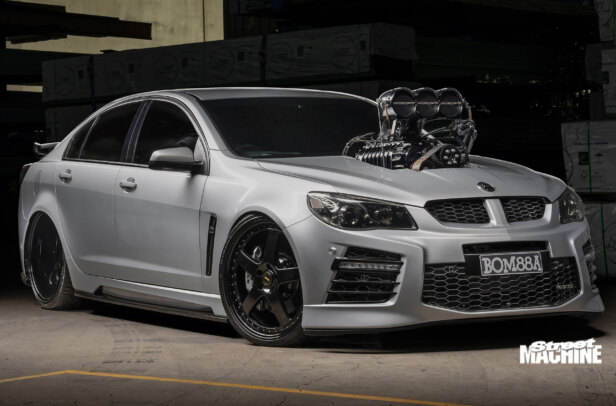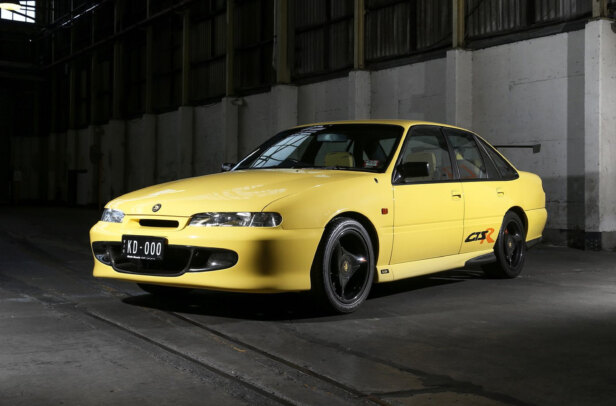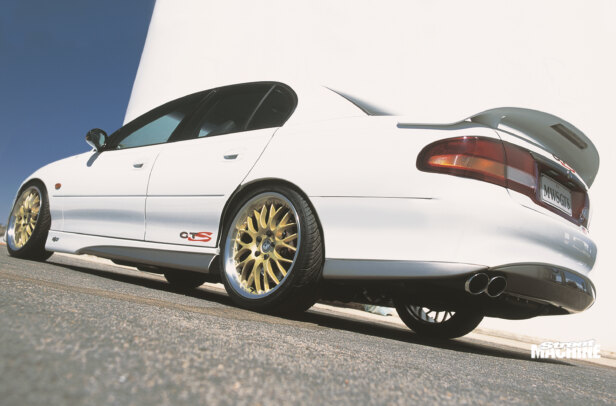This article on James’s HSV GTS was originally published in Street Machine’s LSX Tuner magazine, 2015
JAMES Sera is a bloke who likes to go fast, but he’s usually doing it with his bum about 10mm off the ground in a racing go-kart, as evidenced by the several national and state titles he has to his name.
So it’s not surprising that his street car has a little more go than when it left the factory – which takes some doing when it’s a VE-series HSV GTS that already had 325kW straight off the showroom floor.
The car started off with the usual mods: a cam, OTR intake and a three-inch exhaust. But that wasn’t enough to satisfy James, so he ended up taking the car to Autotechnique/VCM Performance, in Melbourne’s Knoxfield. I gave them a call and had a quick chat to Steve, who gave me some of the back-story.
It looks like it could have come out of the factory like this. Magnuson has done an amazing job engineering a blower set-up with a built-in intercooler that all fits under the bonnet
“James had the idea of supercharging the LS3 later on, so we installed a camshaft that would suit a boosted engine,” Steve says. “Eventually the time came and we happened to be embarking on a very interesting project named Heartbeat – the most efficient supercharger system that we could produce with technology from this decade.
While the engine is now an LSX-based 427 stuffed full of forged internals, the PCM and ignition system are as they left the factory, with tuning now handled by HP Tuners VCM Suite
“Back in the early 2000s James had a VL Commodore, 1TUFRB, which ran nines, and that’s where he wanted to be – back in the nines.”
That badge on the rear should be updated – it’s more like 825 than 325 now! That might give the game away, but who would believe that this stock-looking HSV would be making over 1000hp at the motor?
So James’s GTS became a test bed for a lot of the R&D work for the Heartbeat project – it was going to be quite a while before he got his hands back on it. “We selected the old faithful VCM16 camshaft, some Higgins heads from Nathan Higgins himself and a VCM/Squash Performance fuel system,” Steve says. “We also decided to get on the E85 bandwagon at this stage.”
With the above combo – still with the stock LS3 bottom end – the car made 537kW at the wheels with just over 11psi. The Magnuson Heartbeat blower was working out a treat and there was a lot learned from the process. “The inlet air temps were the lowest we had ever seen at that boost level,” Steve says. “This allowed us to run more timing and/or compression if we liked. Damn that supercharger was efficient!”
It was time for James to run a few passes at Calder Park with the new combo. On a set of Hoosier 28×10 slicks and still running the six-speed manual, James ran a best of 10.90@135mph. “That’s no slouch and it gave us a good baseline to work with – but it wasn’t a nine-second pass,” Steve says.
There’s a reason most people drag race with an auto trans, and if James wanted to get into the nines, that was the direction he was going to have to go. The decision was made to slot in a Pro-Matic Turbo 400, which isn’t that straightforward in a late-model car. “We had a custom tailshaft made, a custom mount for the trans, and a trans cooler with steel lines was made up to suit,” Steve explains. “A lot of custom work went into this stage of the build as the VE was never designed with a Turbo 400 in mind. The shifter install was another large feat as we didn’t want to cut any holes in the tunnel.”
Not surprisingly, with the extra drivetrain losses of the Turbo 400, the car made less horsepower at the wheels. But the good news was, the car was a shitload quicker over the quarter-mile, running a 10.283 at just under 136mph. The trap speed tells you the power was always there, but the ET shows how much better the car got down the track with the trusty old slush-o-matic.
One thing that the team at Autotechnique/VCM were well aware of was the limitations of the stock LS3 block. “From experience, we knew we were pushing our luck with the standard LS3, so we removed it before we broke it. Many hours went into planning the new engine and our first choice for engine builder was Sam Baghdadi from Sam’s Performance in Sydney,” Steve says.
The basis for the new engine was an LSX block, but that was just the start. Sam spent about 40 hours preparing the block, modifying the oiling system, setting up sprayers on the piston skirts and generally making sure the thing would live with the expected power levels. We all know that there’s no replacement for displacement, so 427 cubic inches sounded like a nice number.
Before the blower even gets cranking, there’s 11.5:1 compression in the motor, and although the specs on the solid cam are a secret, Steve could tell us that it has around 700thou lift and somewhere around 240° duration at 50thou. MAST Motorsport heads were fitted with T&D rockers, and when the whole lot was bolted together, the boys from VCM flew up to Sydney to spend a day tuning the engine.
“The first few runs on the engine dyno usually tell you a power figure close to what you will make in the end. The first run was 908hp – we all looked at each other and wondered if we would break 1000hp,”
Steve says. A few more runs netted improvements but they couldn’t quite crack that magic four-digit figure.
The B&M Magnum shifter and MSD shift light are the only deviations from stock, and why would you change it? This car retains all of its creature comforts, and there are plenty of them
On close inspection they could see the throttle blade was moving and twisting, so Sam suggested placing a vacuum gauge behind the throttle but before the rotor assembly.
“What we learnt was that the factory 90mm throttlebody couldn’t keep the Heartbeat fed at high boost and revs, and the vacuum was actually trying to pull the throttle blade shut because the electric motor wasn’t strong enough to hold it open,” Steve says. “We spoke to Ken Nunn at Magnuson and he suggested we use the 108mm throttlebody on the 427.”
That change alone saw them pick up 50hp and they finally broke the 1000hp barrier. With a few more changes in the tune, they ended up with final figures of 1091hp and 999lb-ft. With the engine bolted into the car, it was now making 839hp at the wheels with only 12psi of boost!
Following an invite to the King Of The Street event at Heathcote, it was time to swap the polished Simmons FR22s for some race rubber. As it was a radial-tyre-only event, James put some MH Racemaster 275 tyres on the back – but they were no match for the engine’s instant torque. Launching in second gear was the only solution, and after a day of racing, James’s best ET was 9.89@149mph.
Mission accomplished. The feat is even more impressive when you consider the car was raced full weight at 2100kg.
For now though, James simply intends to drive this monster on the weekends with his wife.
JAMES SERA
HSV GTS SEDAN
DONK
Type: LSX 427
Blower: Magnuson Heartbeat 2300
Heads: Mast Motorsport
Cam: .700 lift, 240°@.050
Pistons: Diamond forged
Crank: Callies Dragonslayer
Conrods: Callies Ultra I-beam
Exhaust: Manta extractors, twin 3in exhaust
Ignition: Standard
SHIFT
Box: Turbo 400
Converter: TCE 3500 stall
Diff: Sheet-metal nine-inch centre
BENEATH
Springs: Pedders coil-overs (f & r)
Steering: Standard
Brakes: HSV (street); Omega (race)
ROLLING STOCK
Rims: Simmons FR22 (street); Weld V-series and steelies (race)
Rubber: Kumho (street); front runners and 26x10x16 slicks (race)




Comments